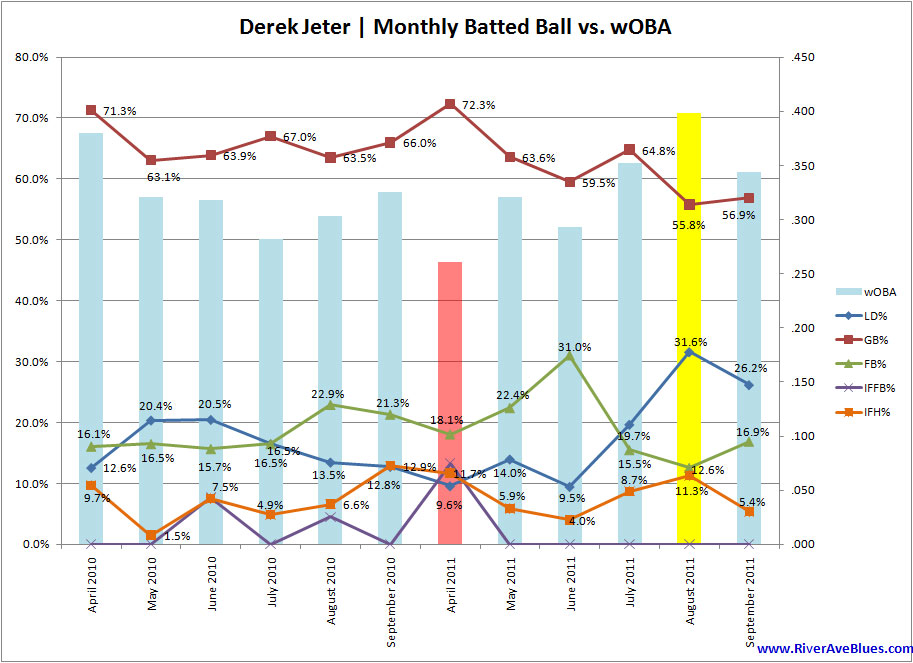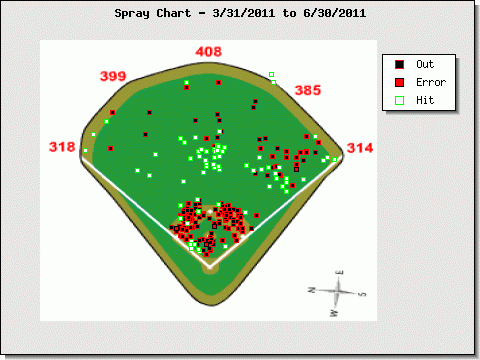
I’ve given Derek Jeter a considerably hard time since his offensive game started to fall off a cliff back in May 2010, and so it seemed appropriate to reverse course and give Derek proper due for the remarkable turnaround that saw him hit .327/.383/.428 in the second half of 2011 after a .270/.330/.353 first half and a .270/.340/.370 2010 season. Additionally, while many have acknowledged Derek’s resurgence, few (if any) have taken a look into the why, and so here’s a deeper dive into how Derek Got His Groove Back (and no, it has nothing to do with gift baskets).
The below chart (as always, click to enlarge) shows Derek’s plate discipline numbers graphed against his wOBA on a month-by-month basis, beginning in April 2010.
There’s obviously quite a bit going on here, and I was actually surprised to find that a lot of this data didn’t correlate the way I was expecting it to. I figured Jeter’s best months would feature low O-Swing% and O-Contact% rates; and yet his best month (August 2011’s .398 wOBA) featured his third-highest O-Contact% (77.6%) out of the 12 months shown here. For a player with a career 62.0% O-Contact%, I really have no idea what to make of that.
Fortunately his four best months of the last 12 — August 2011, April 2010’s .380 wOBA, July 2011’s .352 wOBA and September 2011’s .344 — were each among his top four Z-Swing% rates (though not in that exact order), lending some sense of order to the proceedings. Although only two of those four months — again, April 2010 and August 2011 — were among the top four Z-Contact% rates.
The other data type that correlated with Derek’s top monthly wOBAs was Swing%, as his three highest Swing% months were also his three best wOBA months. So based on this data it seems like Derek is at his best the more frequently he swings, which is also driven home by the below table:
| O-Swing% | Z-Swing% | Swing% | O-Contact% | Z-Contact% | Contact% | Zone% | Sw-Strk% | |
| 2010 | 28.2% | 67.2% | 47.1% | 69.2% | 92.9% | 85.5% | 48.3% | 6.7% |
| 1H 2011 | 26.9% | 66.8% | 45.8% | 73.1% | 91.6% | 85.9% | 47.3% | 6.4% |
| 2H 2011 | 29.9% | 71.7% | 48.9% | 71.5% | 90.6% | 84.3% | 45.5% | 7.5% |
Although that probably isn’t terribly surprising news to anyone who’s watched Derek with any frequency of late. While Derek’s never been a notorious hacker (his career 8.9% BB% is certainly respectable) he has seemed less inclined to take ball four as he’s gotten older, and indeed, he’s only exceeded the league average BB% once in the last five seasons (though he did match it last year). This past season his walk rate was 7.6% against a league average of 8.1% — a five-year league-average low.
Of course, plate discipline only tells part of the story; we also need to see what Derek did with the balls he put into play.
Now this chart makes a little more sense. Derek’s worst month — April 2011 — also featured his highest GB% of the 12 months surveyed here, a ridiculous 72.3%. On the flip side, Derek’s best month, August 2011, saw the fewest ground balls (55.8%). His best LD% months were, unsurprisingly, August ’11 (31.6%) and September 2011 (26.2%). He’s only exceeded 20% line drives in a full season once in the last five seasons, so Derek really turned back the clock this past summer.
I also thought it’d be interesting to see how pitchers attacked Derek over the last two seasons. Instead of drilling down on each individual pitch type, I decided to borrow Mike’s binning of Fastballs (FB%=FF, FT, SI, FC, FA and FS), Breaking Balls (BrB%=SL, CU, KN) and Changeups (CH%).
 First-half Derek saw a slight decrease in fastballs from 2010, an uptick in breaking balls and a very small decrease in changeups. However, pitchers on the whole seemed to start challenging Derek with more heat in the second-half, which is probably at least partially responsible for his offensive resurgence, as Derek’s been an above-average fastball hitter for all of the years in which we have data for.
First-half Derek saw a slight decrease in fastballs from 2010, an uptick in breaking balls and a very small decrease in changeups. However, pitchers on the whole seemed to start challenging Derek with more heat in the second-half, which is probably at least partially responsible for his offensive resurgence, as Derek’s been an above-average fastball hitter for all of the years in which we have data for.
Pitchers did continue to exploit his difficulty with the offspeed pitch, and in fact, 2011 was the worst season of Derek’s career in terms of pitch type linear weights for the changeup. Opposing teams undoubtedly know that you can beat Derek with the change, and I wouldn’t be surprised to see that CH% rise even higher next season.
Lastly, I wanted to take a look at where Derek was hitting the ball. Here’s Derek’s first-half 2011 spray chart:
We all know Derek’s made his living going the other way, but Derek rarely pulled anything with power in the first half, hitting 11 balls to left field (though seven went for hits).
Here’s the second-half spray chart:
That’s a nice-looking spray chart. By my count Derek hit 22 balls to left field in the second half, and 21(!) of them went for hits. I’m not saying Derek needs to become a pull hitter or anything crazy like that, but it’s rather remarkable how much different the results were after he started using the entire field.
The one angle I was curious about but didn’t have the tools to dig too deeply into was whether the Yankees faced a disproportionate amount of lefthanded pitching in the second half, though unfortunately none of the usual suspects have the capability of showing platoon splits by half. However, the Yankees only faced (by my count) 21 lefthanded starters out of their 74 second-half games, so even if Derek did presumably continue to feast on southpaws, his numbers were likely also very good against righthanders in the second half as well, a subset whom he has really struggled against (81 wRC+ on the whole in 2011, and 71 wRC+ in 2010).
To summarize, it would appear that the keys to Derek’s second-half resurgence were, in part, as follows: swinging a lot more frequently than he had been doing (and more frequently than league average, but slightly less than league average on pitches out of the zone), hitting the ball in the air, getting a lot of fastballs and pulling the ball to left field. Of course, this begs the question whether any of this is sustainable for the 2012 season (and beyond, if we’re extremely lucky), or if Derek will regress back to being the groundout-to-the-shortstop-on-the-first-pitch machine that frustrated the heck out of Yankee fans for roughly a year-and-a-half’s worth of plate appearances.




Leave a Reply
You must be logged in to post a comment.